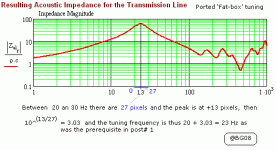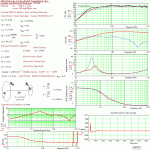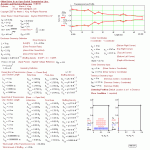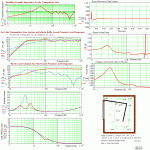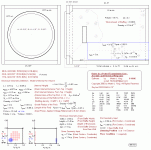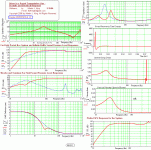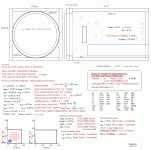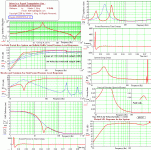bjorno, thank you very much. That I can read! I will build that design and post pics. Is it alright with you if I ask you questions as I build if I have them? First the braces in the port, do the run the whole port and where should I place them.
Thanks again
Dan
P.S. What is the cabinet tuned to?
Thanks again
Dan
P.S. What is the cabinet tuned to?
…I will build that design and post pics. Is it alright with you if I ask you questions as I build if I have them…
Of course, but have patience as Im a quite ‘slow’ when posting here …

Only brace the two perpendicular and straight sections, actually, you can trim the tuning later without exceeding max air velocity with perfect cut braces pushed inside in order to narrow the effective diameter of the port, as the air volume velocity from beginning is very low.
Start using 2 braces in order to divide the port into 3 equally dividings, don’t glue until you have accepted the result sonically.
… P.S. What is the cabinet tuned to?…
See picture 1(1)
Now its bedtime…
b
1(1)
Attachments
saabracer23 said:Was that sarcasm GM?
Hmm, maybe a little since for the specified app it's the type of so-so overall performing alignment I suggested avoiding and combined with both bjorno and PE clearly not agreeing I didn't see much point in turning the thread into a 'who's design criteria is the most right' contest since any type short of sealed or horn loaded will require stuffing the vent(s) to get a high SQ and some much needed VLF driver protection for some movie's special effects.
GM
I apologize if I didn't get it clearly, do you think bjorno's design is a good one that will work, or that in short pe design and his are somewhat the same? Are you saying that the TQWT will sound better?
Dan
Dan
FYI,
Here is a simulation of a TQWT using the same driver in a box with same volume and can be directly compared by overlaying the plots as they have he same scaling.
IMO, Once you try folding this TQWT one time it is still larger and more than on time it cannot excel with lower gross volume or smoother FR if compared to the "fat-box" if the dedication is for a Sub.
b
1(1)
Here is a simulation of a TQWT using the same driver in a box with same volume and can be directly compared by overlaying the plots as they have he same scaling.
IMO, Once you try folding this TQWT one time it is still larger and more than on time it cannot excel with lower gross volume or smoother FR if compared to the "fat-box" if the dedication is for a Sub.
b
1(1)
Attachments
looking for design specs to build a sub for a 18'' RCF 1000w driver.will be used mainly outdoors.any info will be appreciated.
Hi,
FWIW you are messing about with a driver designed towards in car use.
This does not mean it is a bad driver, rather it is optimised for use
with compact boxes and nothing will change that. A bog standard
vented box of ~ 1.6cuft tuned to 23Hz seems the obvious choice.
🙂/sreten.
FWIW you are messing about with a driver designed towards in car use.
This does not mean it is a bad driver, rather it is optimised for use
with compact boxes and nothing will change that. A bog standard
vented box of ~ 1.6cuft tuned to 23Hz seems the obvious choice.
🙂/sreten.
Anyone know of a YORKVILLE design sub,somewhat resembling a single scoop.with the driver positioned inside in an upward direction.
FYI,
Here are two more simulations; first if not a front port (or slotted) or tuned at 23 Hz but ported (tube-port) as small as practically possible without the port is restricting good behaviour/performance for home HT use.
See pictures 1(4)-2(4).
Last pictures 3(4)-4(4), a 1.6 cuft-ported box tuned at 23 Hz that IMO is a bad design and I wouldn’t rec. for home use, unless the port is plugged.
b
1(4)
Here are two more simulations; first if not a front port (or slotted) or tuned at 23 Hz but ported (tube-port) as small as practically possible without the port is restricting good behaviour/performance for home HT use.
See pictures 1(4)-2(4).
Last pictures 3(4)-4(4), a 1.6 cuft-ported box tuned at 23 Hz that IMO is a bad design and I wouldn’t rec. for home use, unless the port is plugged.
b
1(4)
Attachments
bjorno said:FYI,
Here are two more simulations; first if not a front port (or slotted) or tuned at 23 Hz but ported (tube-port) as small as practically possible without the port is restricting good behaviour/performance for home HT use.
See pictures 1(4)-2(4).
Last pictures 3(4)-4(4), a 1.6 cuft-ported box tuned at 23 Hz that IMO is a bad design and I wouldn’t rec. for home use, unless the port is plugged.
b
1(4)
Hi,
Increasing the box from 1.6cuft to 2.0cuft is reasonable but you
are chasing your tail when going past a box volume of the Vas of
the driver. Personally I do think it has been designed for sealed
box loading. For vented you need to go up to driver Vas, which
is generally not a good idea as air compliance is far more linear
than suspension compliance, distortion is not modelled.
🙂/sreten.
- Status
- Not open for further replies.
- Home
- Loudspeakers
- Subwoofers
- Help designing ported cabinet for dayton rss315ho
